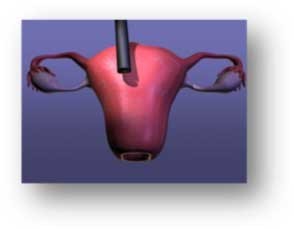New Treatment for Fibroids – Acessa
The Acessa procedure is a new minimally-invasive, same-day (outpatient) therapy for fibroids. It uses a technology called radiofrequency ablation. Each fibroid is destroyed by applying energy through a small needle array. The surrounding normal uterine tissue is not affected. The destroyed tissue may then be completely reabsorbed.
Uterine fibroids are a large part of most Gynecologists’ practice. The severity of the patients’ symptoms can vary widely, as every physician knows, but the challenges of treating each patient effectively remains. The current treatment choices either leave the patient at significant risk of recurrence or subject the patient to significant long term health risks.
The Fibroid Treatment Collaborative is the first to adopt Acessa technology as first line treatment for the management of fibroids.
A study published in the Journal of Obstetrics and Gynecology in May, 2013 showed that women undergoing Acessa radiofrequency ablation of fibroids reported that their symptom severity decreased from a baseline mean transformed score of 61.1 to 26.6 at 12 months postprocedure. Health-related quality of life improved from a mean transformed score of 37.3 at baseline to 79.5 at 12 months. At 12 months postprocedure, total mean myoma volume decreased from baseline by 45.1%. Ninety-four percent of the women reported satisfaction with the treatment.
Physicians Want A Better Solution For Their Patients
Gynecologists want to provide a way for their patients to have their fibroids treated in a minimally invasive manner that allows for minimal complications and a rapid recovery, while minimizing the chance of recurrence of the fibroid symptoms. Doing so will ensure patients don’t seek treatment outside their physician’s practice and provide great patient satisfaction.
AcessaTM System Offers a Better Option
The Acessa System presents a new alternative for patients suffering from uterine fibroids. By having a surgeon treat with the Acessa System, a woman will be able to eliminate the symptoms of her fibroids while keeping a healthy uterus, allowing her to return to a normal quality of life, without the potential long-term complications due to hysterectomy. The procedure is done in an outpatient setting using a minimally invasive procedure, allowing her to have little scarring and enabling her to go home the same day. Best of all, the chances of her experiencing a recurrence of symptoms due to fibroids is extremely low.
- 94% Patients were satisfied with the treatment
- 98% Patients would recommend to a friend
- 94% Patients responded that the treatment had been effective in eliminating their symptoms
Many issues impact which treatment option a patient may choose. Some of these things include:
- whether or not you are having symptoms from the fibroids
- if you might want to become pregnant in the future
- the size of the fibroids
- the location of the fibroids
- your age and how close to menopause you might be
The Acessa procedure is a new minimally-invasive, same-day (outpatient) therapy for fibroids of all types and sizes, in all locations within the uterine wall. It uses a technology called radiofrequency ablation. Each fibroid is destroyed by applying energy through a small needle array. The surrounding normal tissue is not affected. The destroyed tissue may then be completely reabsorbed.




Uterus Mapped for Fibroids
The laparoscopic ultrasound probe is used to determine the location and size of all fibroids present. Intra-abdominal ultrasound allows excellent visualization of fibroids as small as 2 mm in diameter.
Handpiece Introduced into Fibroid
The Handpiece tip is advanced into the fibroid with ultrasound guidance.
Deployment of Handpiece Electrodes
The electrode array is deployed. Laparoscopic and ultrasound evaluation confirm that the electrodes remain within the fibroid.
Ablation and Withdrawal
The appropriate duration of ablation is determined, the treatment is applied, and any bleeding is controlled as the Handpiece is withdrawn.
